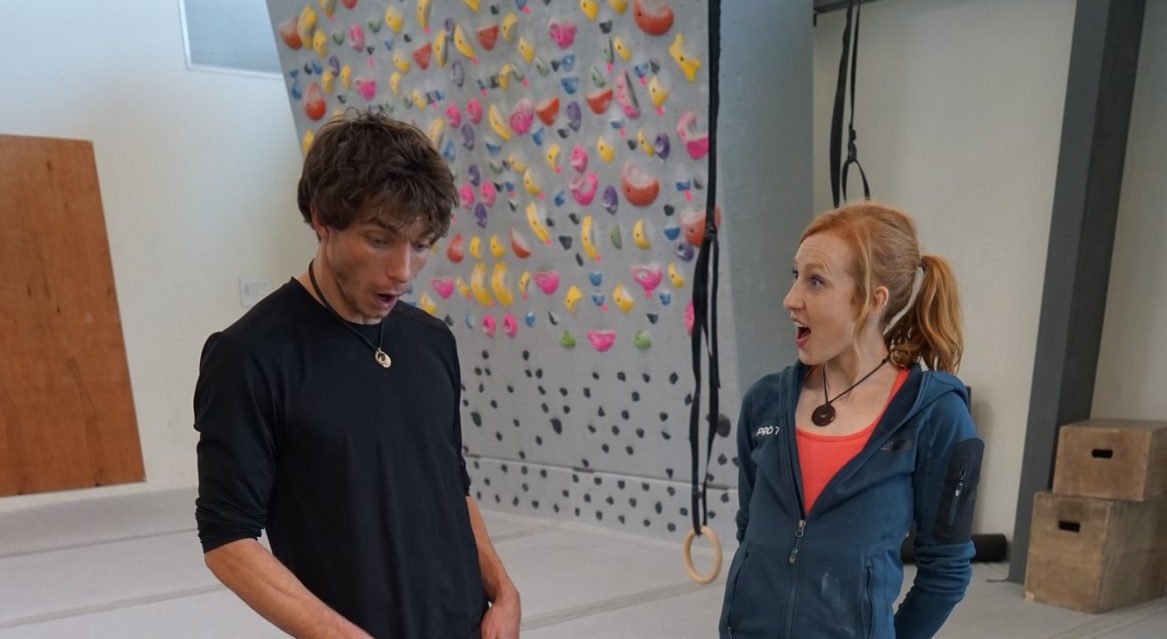Delaney Miller and Ben Rueck couldn’t be more different in their styles and experiences with rock climbing—yet both are incredibly accomplished climbers in their own right. Delaney is an exceptionally graceful climber recognized for her success in the competition circuit, while Ben is a multi-disciplined expedition climber known for his first ascents around the world.
So what in the world are a competition climber and an expedition climber doing in the same interview? I had the same bout of confusion when I met up with Ben and Delaney at Denver’s Movement Climbing Gym to hear about an adventure they were plotting …
In this interview, we get the scoop on this unlikely duo’s upcoming expedition, insight into the gear they use, and some training tips that you can incorporate into your own climbing regimen.
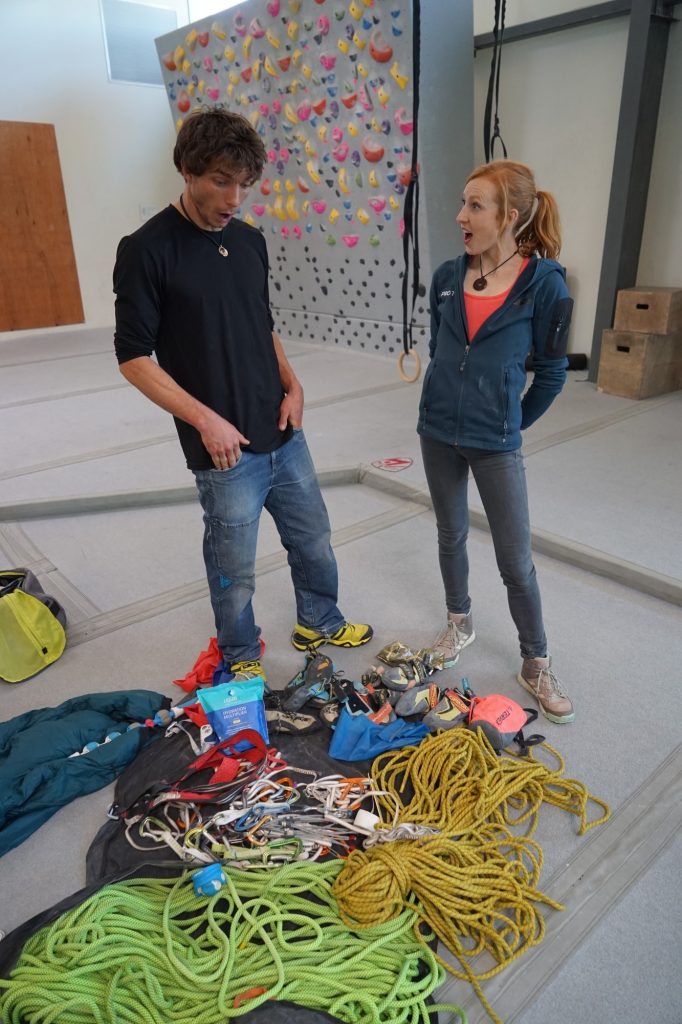
What are these two doing here together? All photos: Ryan Pace
Quick bites
Name:
Current home:
Years climbing:
Dream destination:
Most memorable climb:
Go-to crag snack:
Most valuable non-gear item:
Last book read:
Current song on repeat:
Ben Rueck
Boulder, CO
13 years
Sardinia, Italy
Pure Pressure (5.14-)
Homemade energy bars
Liquid I.V. Hydration Multiplier
Art of Learning
Nights on Fire, David Nail
Delaney Miller
Frisco, TX
10 years
Spain
Epic-ing on Bum Boy (V3)
Dark chocolate
Climb On! / FrictionLabs chalk
Art of Learning
Bad and Boujee, Migos
We’re here at Movement Climbing Gym in Denver, where you guys are training for a big adventure. Can you tell us about the expedition you’re embarking on together?
BR: In about a month we’re headed to Corsica, and what we’re going to do is try and climb a route there on Punta di U Corbu.
Arnaud Petit put up a climb there called Delicatessen (8b/5.13d, 5 pitches) in 1992 and it took 10 years for anyone to repeat it, so we’re going to try and get the fourth ascent of it. It’s only 600 feet of granite climbing, but it’s stacked: 13d to 13a to 13b to 5.11c and then the last pitch is 13c.
What made you guys decide to try out this route?
BR: Google. It showed awesome rock faces. What we saw there were these really well sculpted … what would you call them?
DM: They’re basically massive huecos.
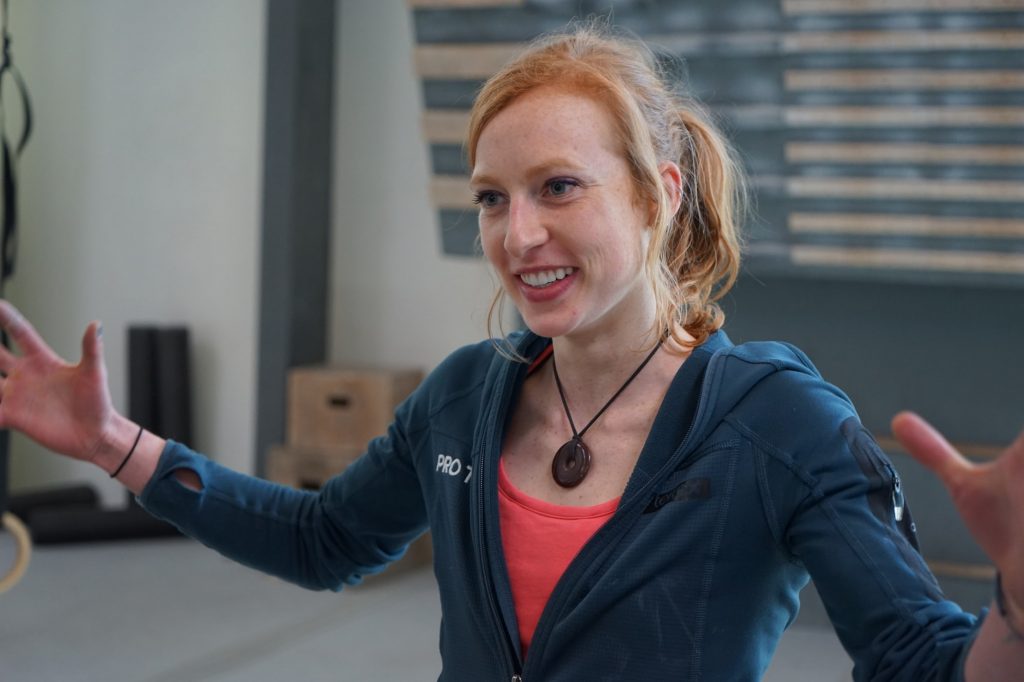
Delaney describes the look of the terrain on the route.
BR: Yeah, they’re huge. You crawl in and out of them and it looks like an old piece of architecture or a weird sculpture where someone just took an ice cream scoop and cut out these really awesome ledges on a very good face. It looked so cool and like 3d climbing.
Also, it’s recommended as one of the best climbs in the world, just relatively unknown—so we decided we should give it a shot.
And what draws you to projects in general? Is there something specific you’re looking for?
BR: The adventure side of expeditions is definitely what draws me to things. With this climb, for example, it wasn’t necessarily the rock face that attracted me to Corsica. I just knew that I’ve wanted to climb in the Mediterranean somewhere, and looking at the map and images that came up, this looked like it would be a different kind of experience. So, it was more of a, “why not?”
DM: I’m like Ben in that I want it to be new and different, but also I want the rock to be inspiring. I seek out aesthetic routes. I want it to be taller so that I can get to the top and look around and be inspired by my surroundings.
Watch Ben’s journey to climb Pure Pressure (5.14-):
Are you generally seeking a climb within your style that you can push at harder grades, or are you looking for something way out your style?
BR: If I’m picking something close to where I’m located, I’ll pick something out of my style, because I have the time and resources to commit to the long haul. But when I go traveling abroad and only have a small time frame, I try to find climbs closer to what I climb typically, and then later can seek something outside of my style to work on.
DM: It really depends on my goals. If I’m going on a quick trip, I’ll look for something in my style so that I can get lots of climbing in … and feel good about it! But also, doing something outside of your style is incredibly satisfying, because your creativity is challenged and you’re pushed in a different way.
A look at Delaney’s rise in competition climbing:
How did you two decide to team up together? Seems like an unlikely duo.
BR: Random luck and chance! I didn’t have a partner and I asked her what she was doing in March. She said she had nothing going on, so I told her she was joining me on a multi-pitch adventure!
DM: Yeah, it will be pretty new to me. I’ve done a little bit, but Ben is basically going to have to teach me.
BR: Someone taught me, so it’s my turn to play mentor.
Awesome. Let’s take a look at the massive ensemble of gear you guys have here. Sis gotart with the ropes you’re planning to bring.
BR: Right now I’m using the 9.2 Aero from Sterling, and it’s honestly one of the most durable ropes I’ve ever had. I had an original prototype and was able to climb all through Madagascar with it, putting up a new big wall route with Mayan [Smith-Gobat] and we didn’t deal with any core shot or fuzziness on the rope at all. So this guy is going with me for sure. It’s durable, really lightweight, and easy to use.
The other rope that I have here is this tag line, because we’ll also be trying to put up a new route and will need to haul up drills and bolts with us. So, that’s kind of part two of the expedition. Since hardware is so heavy, I always like to bring a rope and a tag line, which also makes logistics easier when rappelling.
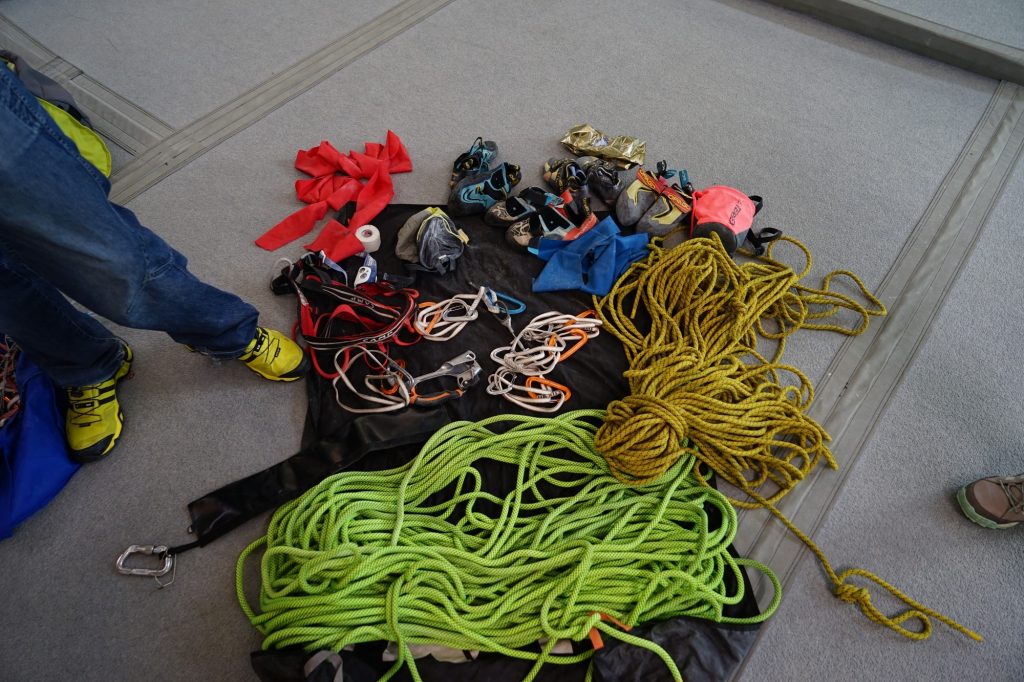
What tips do you have for Delaney, or other climbers new to multi-pitch, when it comes to rope management?
BR: It’s not about speed, it’s just about stacking the rope correctly. If things start to get tangled, it’s just how it goes sometimes, and we’ll just take our time. We’ll definitely do some initial warmups to figure our systems out.
DM: Last time I had to deal with rope management, the rope sort of ended up everywhere. I was solid for the first half, and then it all fell apart … then I realized why I was getting warned about it.
BR: I’ve had epics with ropes so don’t worry—it’s all part of the learning process. There’s no judging!
What ‘draws will you guys be taking up there with you?
BR: We’ll be taking the CAMP Photons, which are some of my favorites. These ones have a straight and bent gate ‘biner, which makes them really easy for clipping. In general, I avoid wire gates, because I feel that they’re less durable and find that I fumble more when clipping them. Also, they’re bright so I can see them on the wall. For how much more metal is on these, they’re really lightweight.
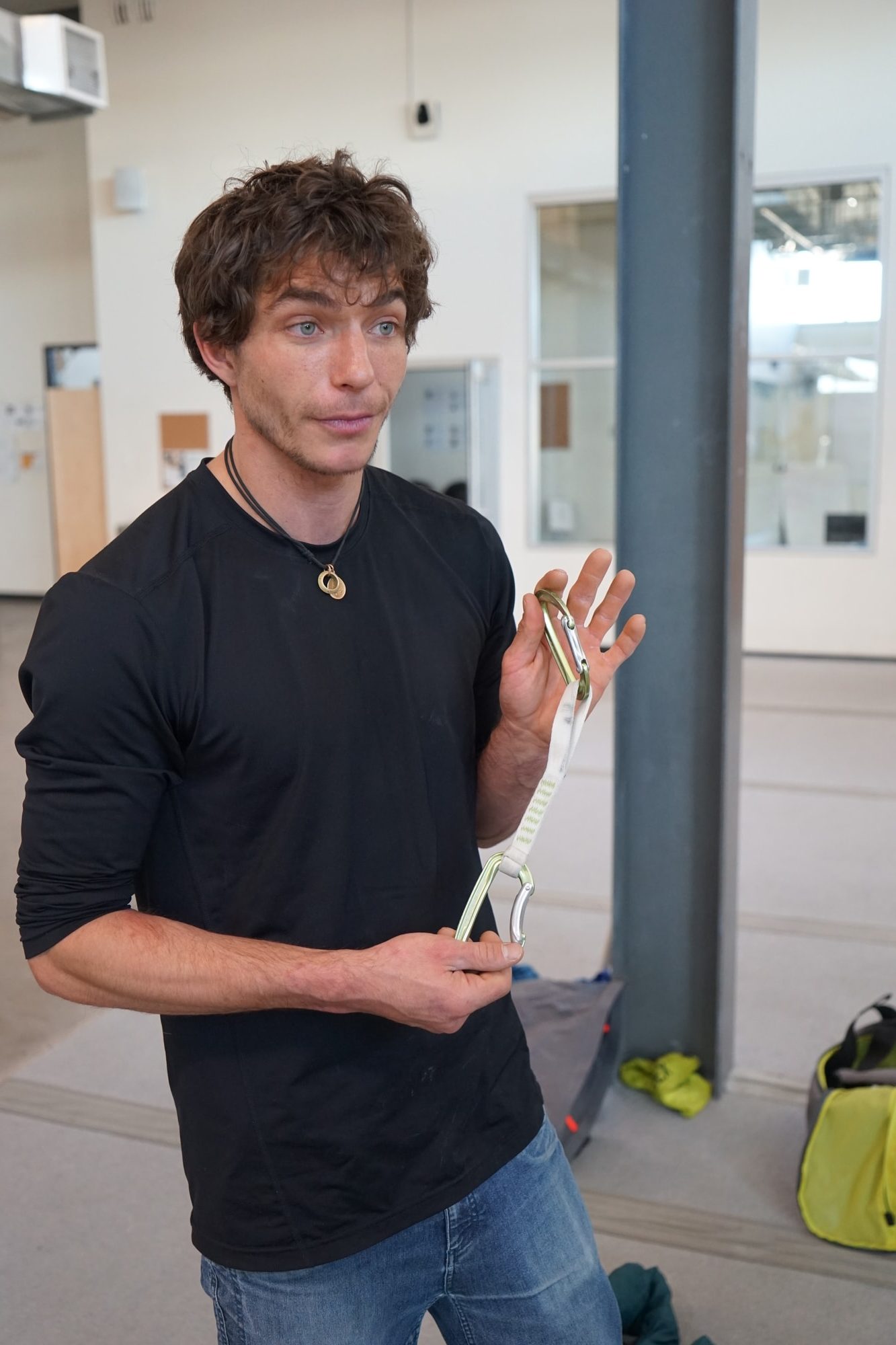
Ben points out features of the CAMP Photon quickdraws.
You both have a couple pairs of shoes here … tell us about them and which ones you think you’ll bring for the climb?
DM: I haven’t decided yet. These are the Scarpa Dragos, which are super comfortable shoes that I can wear for a really long time, which would make them great for a multi-pitch climb, like this one. They’re similar to slippers, really soft shoes with great sensitivity. They’re really nice for volumes and rock texture that’s sloppy-er.
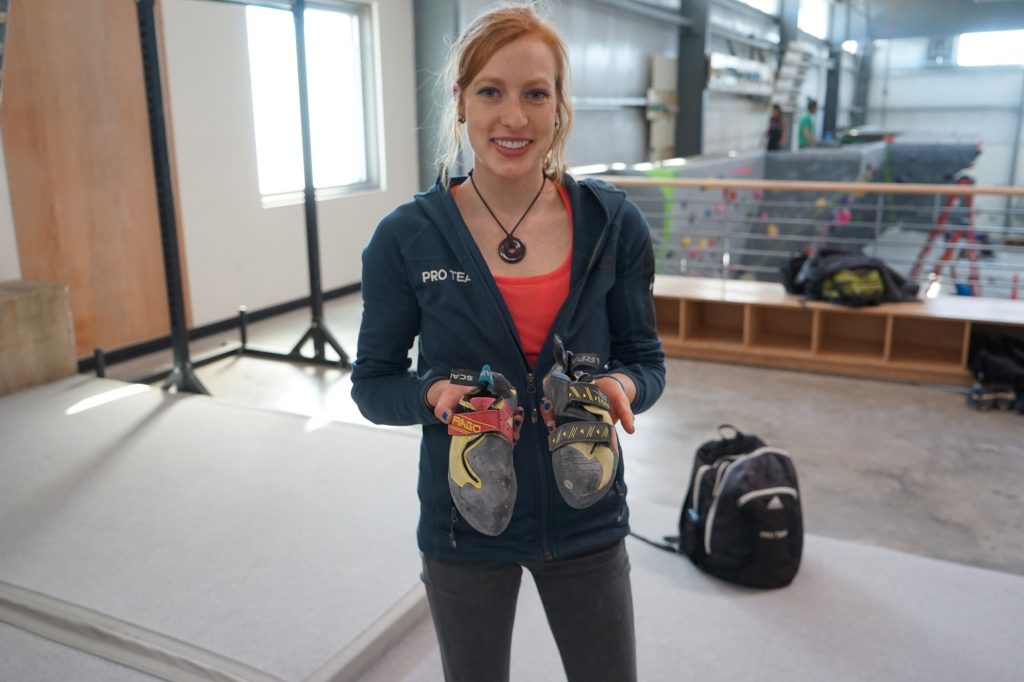
Delaney gives us a look at Scarpa’s Dragos.
… But now that I think about it, for that reason, I’ll probably bring the Boosters, because they’re a bit stiffer, and will be better on the fine edges … which I’m guessing Delicatessen will have plenty of.
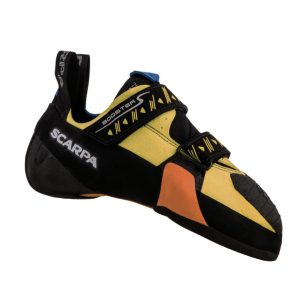
BR: My go-to shoe on this route will probably be La Sportiva’s TC Pro, because it’s going to be really technical granite. These shoes blew my mind in Yosemite. It was unreal how long I could climb in them—basically full 15-hour days. Also, the stuff I was able to stand on in them was unreal.
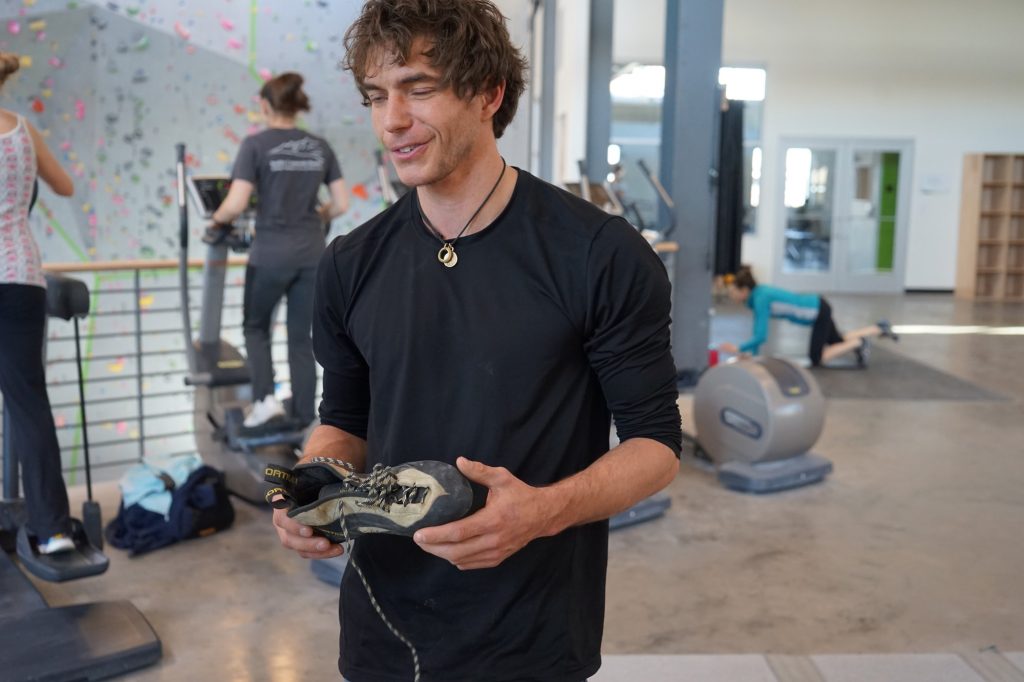
Ben proclaims his love for the TC Pros.
For the main sport pitch on Delicatessen though, I’ll probably use the Futura. These are generally what I climb in whenever I’m trying really hard sport climbs … or have no idea what I’m doing. The Futura is my go-to shoe for projecting.
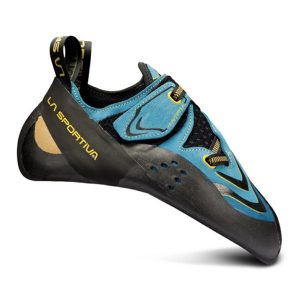
How about the harnesses you plan to take with you?
BR: I’ll be using the Flash harness by CAMP. It’s incredibly lightweight and looks like a g-string … but it’s probably the most comfortable harness I’ve ever had. It has fixed leg loops, which I really like because I can just throw it on. I don’t have to worry about things coming undone or really messing with it ever. I can also sit in it for a really long time because it’s so lightweight.
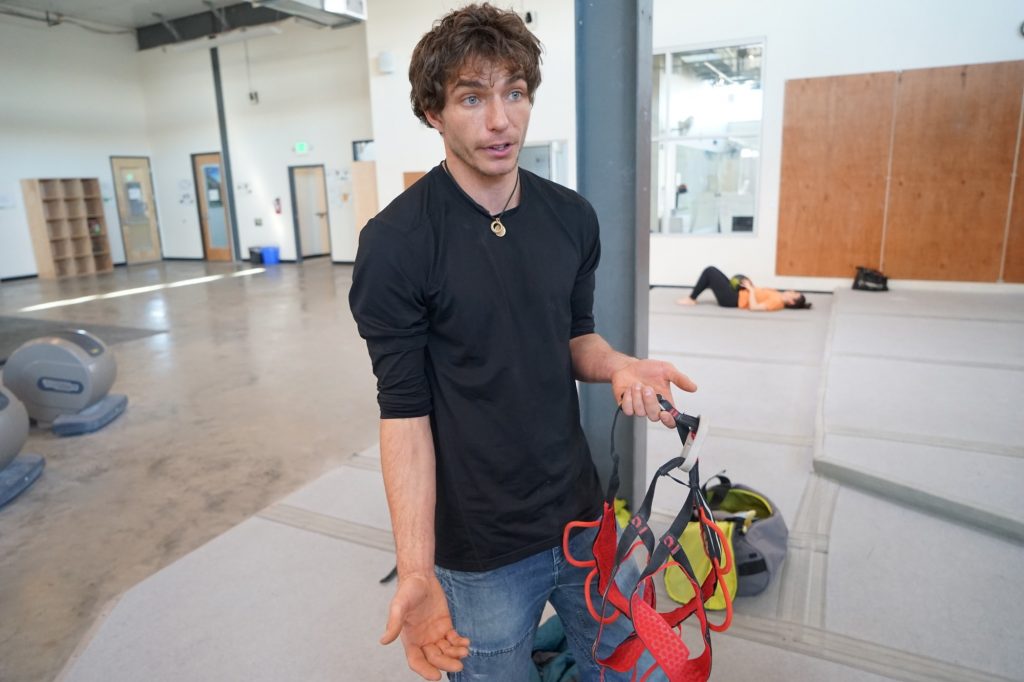
Is it a harness or a g-string?
DM: I’ll be using the Jayne II Edelrid harness. It’s super lightweight, breathable, and built specifically for women, so it fits really well.
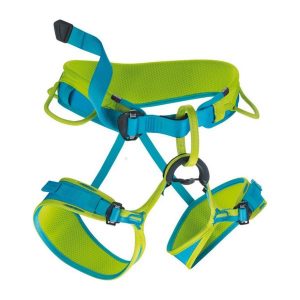
I see you also have some trad gear with you here. Will you be taking some up on this trip?
BR: Absolutely. When putting up a new route I want to use as few of bolts as possible. It’s also really nice to have the gear to use as directionals. For that, I’ll bring some small copperheads and micro nuts. We’re not going to go crazy trying to put up a crazy trad lead, but if there’s a crack, we’ll use gear, which I feel is the proper ethic.
This Black Diamond X4 is a good luck piece. I put it in a really bad sandstone crack at one point and took a massive fall and expected it to rip out. It caught, offset, and then sunk in and held in the crack. If I would have just put a .3 in there, it would have popped out and I would have been dead. But because of the offset, the .2 sunk in and didn’t blow. So now this guy just stays with me wherever I go.
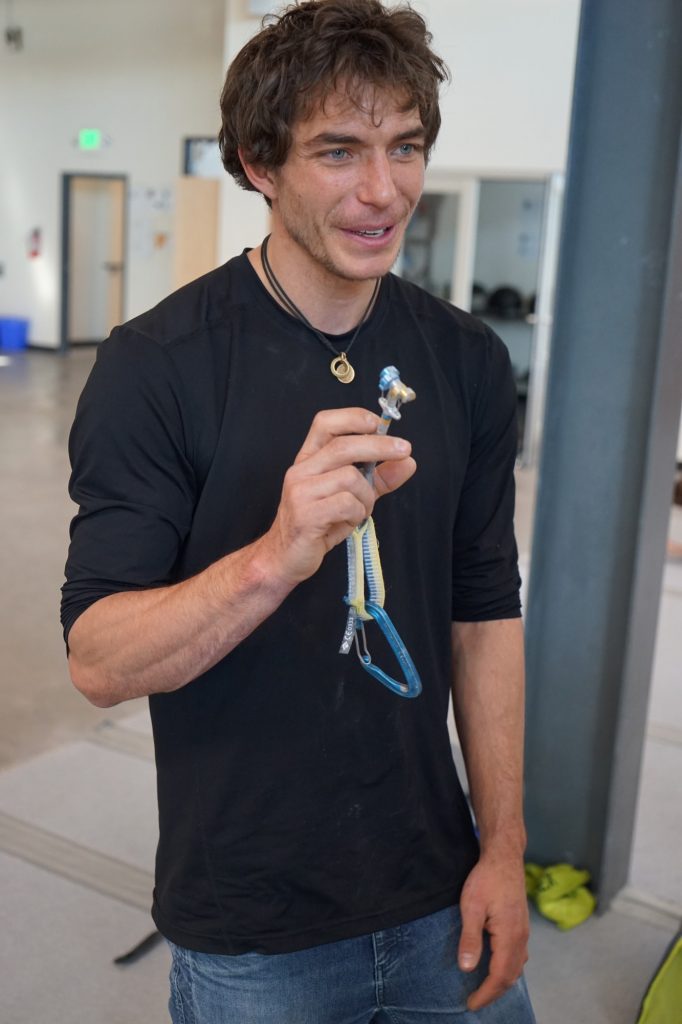
DM: I’ve done like two trad climbs ever. I’m definitely not uninterested in trad climbing. I’ll be doing some on this trip and I don’t really know what’s coming!
And what’s this contraption you have here?
BR: It’s a rope protector. If you’re making fixed lines for a photographer, or on a wall for a long time, and you need to be able to jug up to your last starting point, these guys are clutch. Petzl makes them.
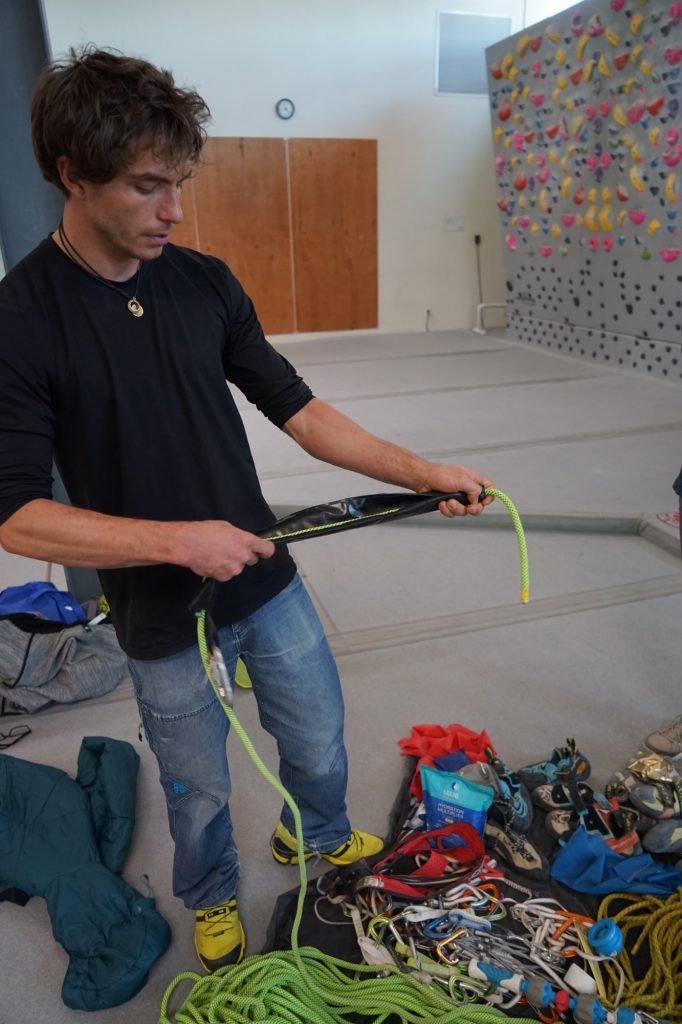
Basically, you’ll find some form of rock that could saw through your rope, and this thing goes on there, velcros together around your rope, and acts as a protector. It also has this clip on it that lets you clip it to the rope so that if you’re jugging past it you can easily unclip it. Five or six of these are always with me.
I’ve core shot ropes jugging, which is the worst experience I’ve ever had. I watched the sheath of a rope start sawing through with hundreds of feet below me. By the time I got up to the rope, I vowed to buy these immediately. It’s terrifying when you see the rope tearing off of a scary edge.
What’s the most important lesson you’ve learned from your experiences on longer climbs?
BR: Staying hydrated. When you’re on multi-pitches and not actually hydrated, you’re pretty much done. You can go hungry—it’s not fun—but if you’re not drinking enough water you’ll lose all of your salts, start cramping, and not be able to think well, and that’s a huge problem. It can lead to really dumb mistakes.
I’ve almost unclipped ‘biners, unclipped myself off the wall, or even started untying my knot after a long day, and so on, which has taught me that you always need to stay hydrated on the wall.
We’re only going to bring 2 liters of water, so staying hydrated will be very useful. Our aim is to do it ground up and in a day, so while it’s only 600 feet, it’s 600 feet of really hard climbing.
Do you have a pre-climbing routine to prepare for a hard climb or competition?
BR: I use this massage roller and work my forearms to try and loosen things up. It also puts me in the space where I know I’m going to try something really hard. There’s a lot of focusing and breathing, and using this to get into a mindset that says, “Okay, we’re not just playing now.”

DM: I do a lot of stretching, particularly with a band. It’s very routine for me. I cannot get on a climb without using this and performing some other stretches, as well. While I’m doing that I try to visualize the route and stare it down.
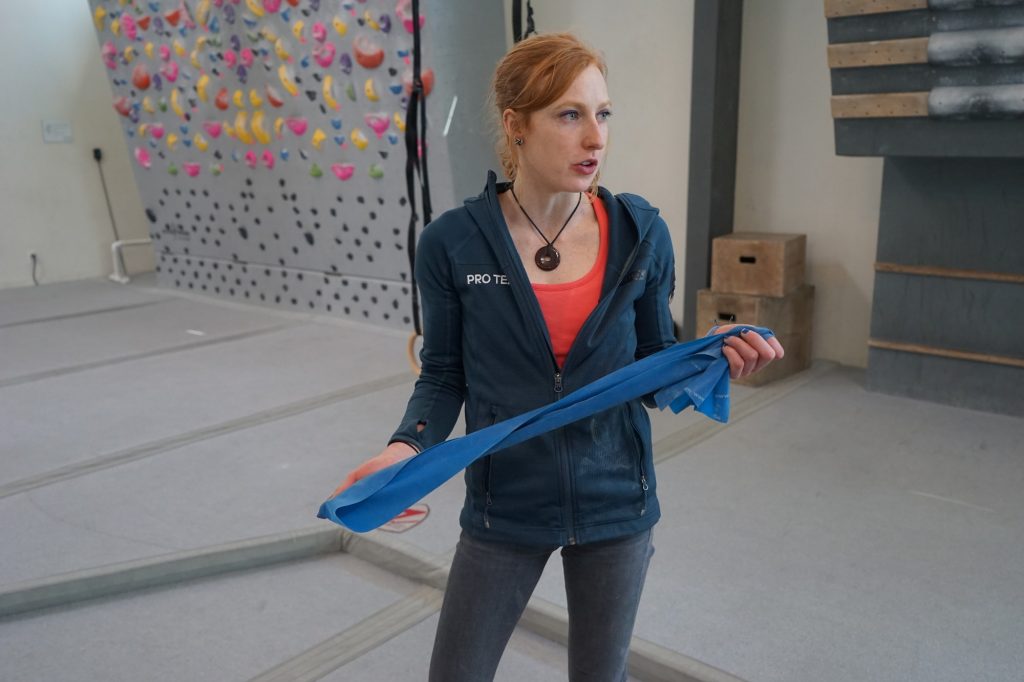
What does your training regimen look like for this expedition?
BR: We’ve actually never trained together—Delaney is on the sport climbing competition side of things, and I’m more of an expedition climber, which actually complements well. Our styles are also completely different. I’m jumpy and dynamic and she’s not jumpy and dynamic at all.
So our training program is basically a fusion of both of those styles. I’m learning a lot about static movement, control, and crimping. I’m hoping she might learn a little bit more about jumping and power movement. Basically, bypassing the tiny things and seeing a jug and just leaping to it. That’s kind of what the idea behind our routine.
DM: We’ll probably train two to three days on of hard climbing and one day off. That’s normally what I do. We’ll balance it out between our usual routines.
BR: I normally do a lot of campus board training and weights. I’m an old man now and my body’s breaking down. I’m 30! Actually, I learned from the guys at Café Kraft that my posture was really bad and if I wasn’t taking care of that, I’d blow my shoulders out. One of my other climbing partners just had to go through many shoulder surgeries, and now I’m at a point where I can make a positive shift in how I train, so I’m working on that.
Instead of doing crazy power all the time, I can actually work on lower back, scapulas, and even legs and core to make sure things stay in position. So, we’ll be doing a lot simple calisthenic type things, and also kettlebells.
DM: Basically, exercises that recruit all the muscles together. Stuff like trap bar lifts and anything that’s full body is really helpful for climbing. You need your whole body to be communicating nicely with each other.
BR: Also—she taught me about one-legged climbing, which is very exciting.
DM: You can do it on a circuit or a route. You climb it once with just the left foot, then once with your right foot, and it’s really hard but a great exercise because it strengthens your legs. They get super pumped, which is an odd feeling because you never really get that.
It’s so good for positioning and working on your technique. When you first start doing it, you assume you have to campus or jump, but then you learn to find ways of doing it statically by flagging or shifting your body position on the wall. You don’t always have a foot where you want it in climbing, so you learn to deal with those situations.
BR: This is where we really discovered our difference as climbers—because I just jumped! My legs were so pumped. So yeah, basically we’ll do a lot of core and tension movement.
What is one thing you can teach one another, and one thing you hope to learn from one another on this expedition?
BR: Delaney is going to teach me what it’s like to be in more of a mentorship role. I really haven’t stepped out of being a mentee. So I get to learn more about my systems and how I work. Which will be nice because she can call me out!
The other thing is that Delaney has such a different climbing style to me that being able to watch it, try to mimic it, and just see how she moves on the wall compared to how I move is really beneficial and can help change the way that I climb. Sometimes jumping isn’t the answer!
DM: I’ve been competing for 10 years—the same amount of time I’ve been climbing. Ben is going to show me what it’s like to be outside for a while, and that will probably open a lot of doors for me, perspective-wise. So I’m really looking forward to that. I’m not really sure what I’m going to teach Ben! Maybe just learning to be more static.
Delaney, as a very accomplished competition climber, do you have any tips for aspiring competition climbers?
My greatest tip is: believe in yourself. I know that sounds really cheesy, but the differences between the good and the great competition climbers are not big. It’s more about how they approach the competition wall and the state of mind that they are able to maintain as they climb a route or problem.
And Ben, what about you? As an accomplished expedition climber of many disciplines, do you have any final tips or words you’d like to share?
Expeditions are fun, adventure, and work. Don’t forget that the experience is worth the pain, one phrase that gets me through the roughest parts, “How bad do you want it?”
Things go wrong—and when they do it is important to remember patience. It is perfectly fine to be angry or upset, but do that in a safe place after you get out of the situation that is causing the stress.
Try, even when you think it’s pointless.
Want more climbing content? Get our awesome climbing newsletter, delivered weekly.
Explore more
- This week’s best rock climbing gear deals
- Our 30+ most popular articles ever
- What’s In Your Pack: Peter Croft on Gear and Alpine Efficiency
- “I Will Climb, Too” — A Story of Mentorship and Responsible Climbing
- What’s In Your Pack: Ethan Pringle
- Video: Ben Rueck and Mayan Smith-Gobat Explore China’s Quingfeng Valley
- What’s In Your Pack: Jonathan Siegrist on His Projects, Climbing in Spain, and Gear Tips
- Ben Rueck and Mayan Smith-Gobat Climb the Tasmanian Totem Pole
- Video: 2017 Bouldering Open National Championship Highlights
- Get daily updates by Liking us on Facebook
- Free rock climbing PDFs on technique, training, knots, and more

